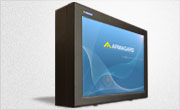Different Types of Touch Screen
Posted by: Richard Williams | Posted on: | 0 Comments
More digital signage systems and information screens are becoming interactive. Interactivity has advantages for both advertisers and information providers. For advertisers, offering an interactive experience encourages an audience to absorb the content. Yahoo’s Bus Stop Derby is a great example of this; the company gets advertising and promotional coverage as people interact with its video game.
Information provision also benefits from interactivity. Touch screens enable delivery of more detailed and tailored information an audience. Most interactive digital signage displays use touch screen, but several forms of touch screen displays exist, and choosing the right system for your needs is important.
Different touch screen systems are effective in different locations and for different uses. Outdoor digital signage, gloved hands, scratches and scuffs, and cold and hot temperatures can all make a difference to the effectiveness of a touch screen.
Types of Touch Screen
There are several types of touch screen all with advantages and disadvantages:
Resistive
Perhaps the most common form of touch screen is resistive screens. Using wire touch technology a resistive touch screen can be operated by both bare and gloved hands (or with a stylus) but is susceptible scratches and burns. Resistive touch screens are only able to be produced in small sizes too—up to about 30”.
Capacitive
Capacitive is another fairly common form of touch screen and uses a capacitive sensor connected to the screen face that detects touch impressions. Mainly used in mobile phone technology. Capacitive touch screen is more expensive to produce for larger screens, though and is not common for digital signage.
Surface Acoustic Wave
Using electric pickups, surface acoustic wave technology is also operational by bare and gloved fingers. The problem with surface acoustic wave, however, is that liquids or dirt on the screen can give false readings—not suitable for most digital signage applications.
Optically Sensed
Optical sensing technology uses cameras to detect touch on the face of the screen. This sort of touch screen will continue to operate when screens get scratched or marked but if liquids move across the screen false positives can arise.
Infrared
Infrared technology is very durable for digital signage, using infrared beams to detect interaction. However, false positives created by solid and liquid contaminants make it unsuitable for outdoor use.
Bending Wave
This sort of technology uses sensor materials and electric pickups to detect interaction. The great advantage of bending wave technology is that it is impervious to contaminants so is ideal for outdoor interaction . The technology, is however, still quite new and the touch facility is limited to single interactions.
Post shortlink:
Popular Products
LCD Enclosure
Need armor for your LCD/LED screen(s)? Outdoors or inside the versatile LCD enclosure protects against thieves, vandals & the weather. Installation idea: NFL stadiums.
Outdoor Digital Signage
Exclusive 46” outdoor screen protection. Dubbed the ‘Totem’, due to its distinct design, it repels damage threats, but attracts audiences. Installation idea: Drive-thru restaurants.
Portrait Flat Panel Enclosure
Safeguard your eye-level advertising display screen(s), indoors or outdoors. Completely customizable, add exciting features like touch screen technology. Installation idea: Restaurant frontages.
Indoor Digital Signage
Popular purchase for retail outlets! Great for ‘point of sale’ persuasion, boost your brand with static & motion advertising from a single unit! Installation idea: Mall of America.




